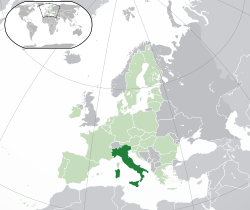
Italy
Country in Southern Europe / From Wikipedia, the free encyclopedia
Dear Wikiwand AI, let's keep it short by simply answering these key questions:
Can you list the top facts and stats about Italy?
Summarize this article for a 10 years old
Italy (Italian: Italia [iˈtaːlja] ⓘ), officially the Italian Republic[lower-alpha 1][13][14] or the Republic of Italy,[15][16] is a country in Southern[17][18][19] and Western[20][note 1] Europe. Located in the middle of the Mediterranean Sea, it consists of a peninsula delimited by the Alps and surrounded by several islands.[21] Italy shares land borders with France, Switzerland, Austria, Slovenia and the enclaved microstates of Vatican City and San Marino. It has a territorial exclave in Switzerland (Campione) and an archipelago in the African Plate (Pelagie Islands). Italy covers an area of 301,340 km2 (116,350 sq mi),[3] with a population of about 60 million;[22] it is the tenth-largest country by land area in the European continent and the third-most populous member state of the European Union. Its capital and largest city is Rome.
Italian Republic | |
|---|---|
| Anthem: "Il Canto degli Italiani" "The Song of the Italians" | |
Location of Italy (dark green) – in Europe (light green & dark grey) | |
| Capital and largest city | Rome 41°54′N 12°29′E |
| Official languages | Italiana |
| Nationality (2021)[1] |
|
| Native languages | See main article |
| Religion (2020)[2] |
|
| Demonym(s) | Italian |
| Government | Unitary parliamentary republic |
| Sergio Mattarella | |
| Giorgia Meloni | |
| Ignazio La Russa | |
| Lorenzo Fontana | |
| Legislature | Parliament |
| Senate of the Republic | |
| Chamber of Deputies | |
| Formation | |
| 17 March 1861 | |
• Republic | 2 June 1946 |
| 1 January 1948 | |
| 1 January 1958 | |
| Area | |
• Total | 301,340[3] km2 (116,350 sq mi) (71st) |
• Water (%) | 1.24 (2015)[4] |
| Population | |
• 2022 estimate | |
• Density | 201.3/km2 (521.4/sq mi) (71st) |
| GDP (PPP) | 2023 estimate |
• Total | |
• Per capita | |
| GDP (nominal) | 2023 estimate |
• Total | |
• Per capita | |
| Gini (2020) | medium |
| HDI (2021) | very high · 30th |
| Currency | Euro (€)b (EUR) |
| Time zone | UTC+1 (CET) |
| UTC+2 (CEST) | |
| Date format | dd/mm/yyyy yyyy-mm-dd (AD)[9] |
| Driving side | right |
| Calling code | +39c |
| ISO 3166 code | IT |
| Internet TLD | .itd |
| |
The Italian peninsula was historically the native place of numerous ancient peoples and destination of a myriad of different peoples and cultures who immigrated throughout history.[23] The ancient Roman state arose in Latium, and expanded throughout the peninsula and the territories around the Mediterranean basin through a process of Romanization.[24] By the first century BC, the Roman Empire expanded its territory across Europe, North Africa and the Near East, establishing the Pax Romana.[25] During the Early Middle Ages, the Western Roman Empire fell, Christian Church arose and Italy experienced inward migration from surrounding tribes. By the 11th century, Italian city-states and maritime republics expanded, bringing renewed prosperity through commerce and laying the groundwork for modern capitalism.[26][27] The Italian Renaissance flourished in Florence during the 15th and 16th centuries and spread to the rest of Europe. Italian explorers also discovered new routes to the Far East and the New World, helping to usher in the European Age of Discovery. However, centuries of rivalry and infighting between the Italian city-states among other factors left the peninsula divided into numerous states until the late modern period.[28][29] Italy's commercial and political power significantly waned during the 17th and 18th centuries with the decline of the Catholic Church and the increasing importance of trade routes that bypassed the Mediterranean.[30]
After centuries of political and territorial divisions, Italy was almost entirely unified in 1861 following Wars of independence and the Expedition of the Thousand, establishing the Kingdom of Italy.[31] From the late 19th century to the early 20th century, Italy rapidly industrialised, mainly in the north, and acquired a colonial empire,[32] while the south remained largely impoverished and excluded from industrialisation, fuelling a large immigrant diaspora.[33] Despite being one of the victorious allied powers in World War I, Italy entered a period of economic crisis and social turmoil, leading to the rise of the Italian fascist dictatorship in 1922. During World War II, Italy was first part of the Axis until it surrendered to the Allied powers and was occupied by Nazi Germany with fascist collaboration (1940-1943) and then a co-belligerent of the Allies during the Italian resistance and the liberation of Italy (1943-1945). Following the end of the war, the country replaced the monarchy with a republic via referendum and enjoyed a prolonged economic boom, becoming a major advanced economy.[34]
Italy has the eighth-largest nominal GDP in the world, the ninth-largest national wealth and the third-largest central bank gold reserve. The country has been described as the "least of the great powers", and it has a significant role in regional[35][36] and global[37][38] economic, military, cultural, and diplomatic affairs. Italy is a founding and leading member of the European Union, and it is in numerous international institutions including the NATO, the G7, the Uniting for Consensus and many more. The source of many inventions and discoveries, the country is considered a cultural superpower and has long been a global centre of art, music, literature, science and technology and fashion.[39] It has the world's largest number of World Heritage Sites (58), and is the world's fifth-most visited country.


.svg/220px-EU-Italy_(orthographic_projection).svg.png)
